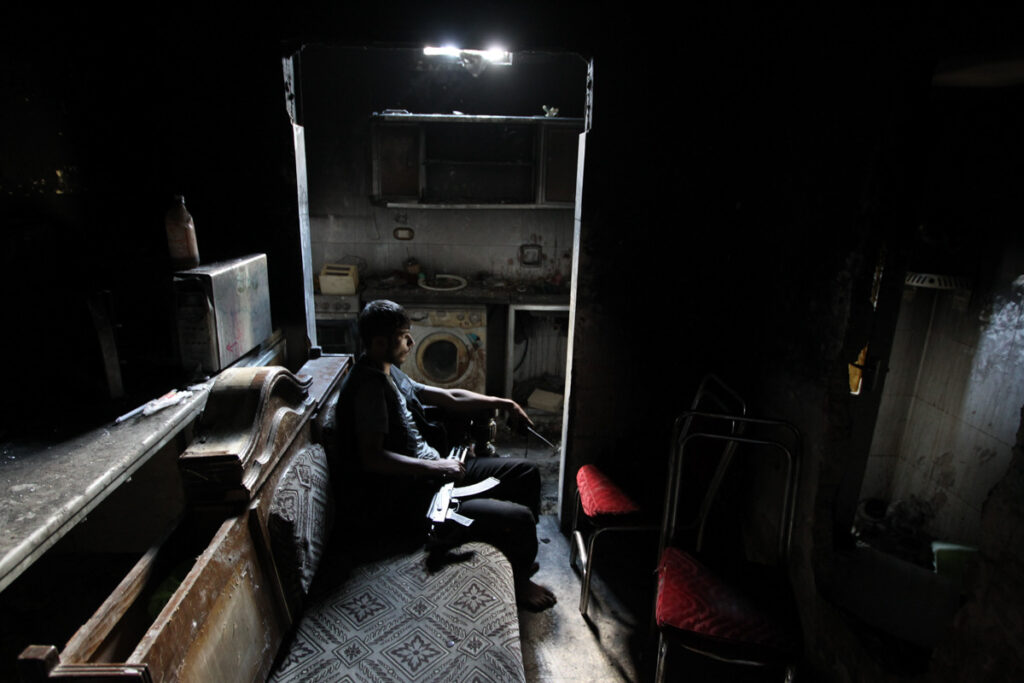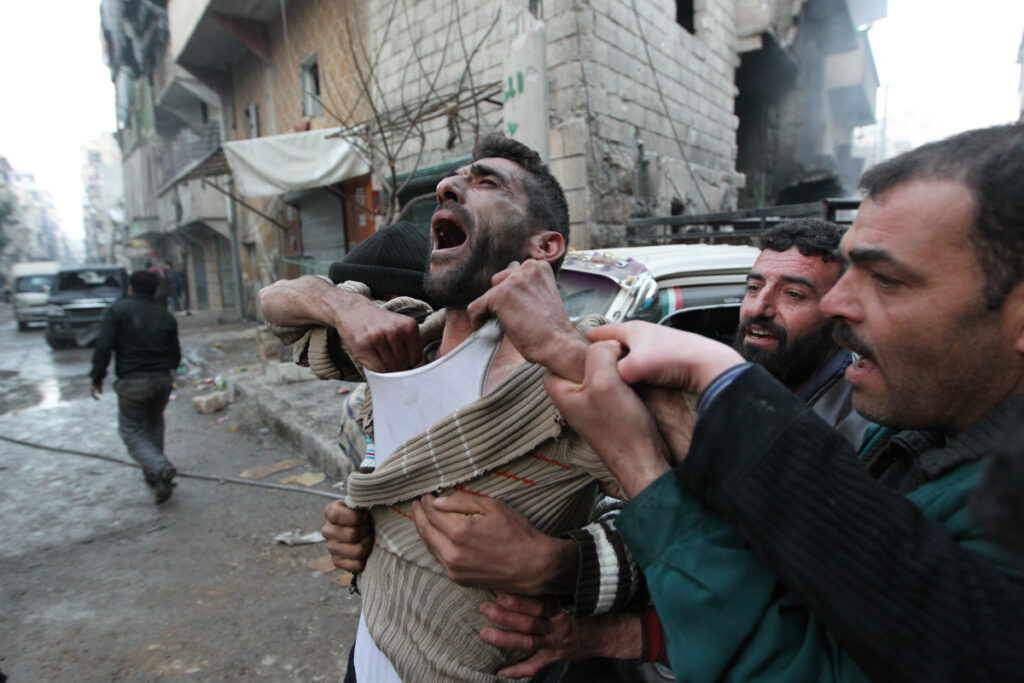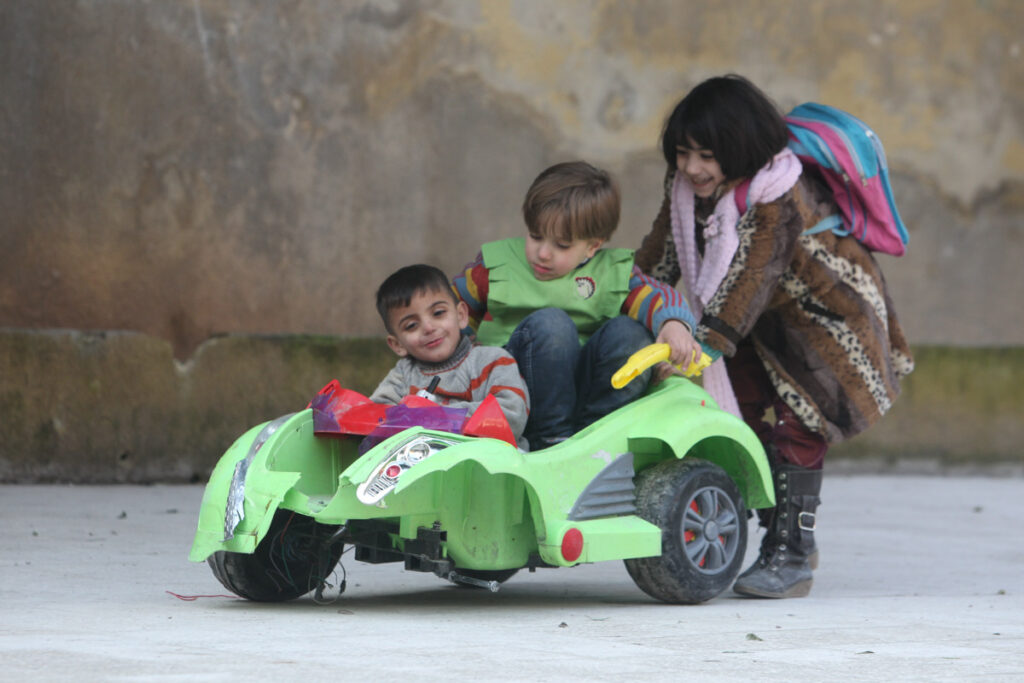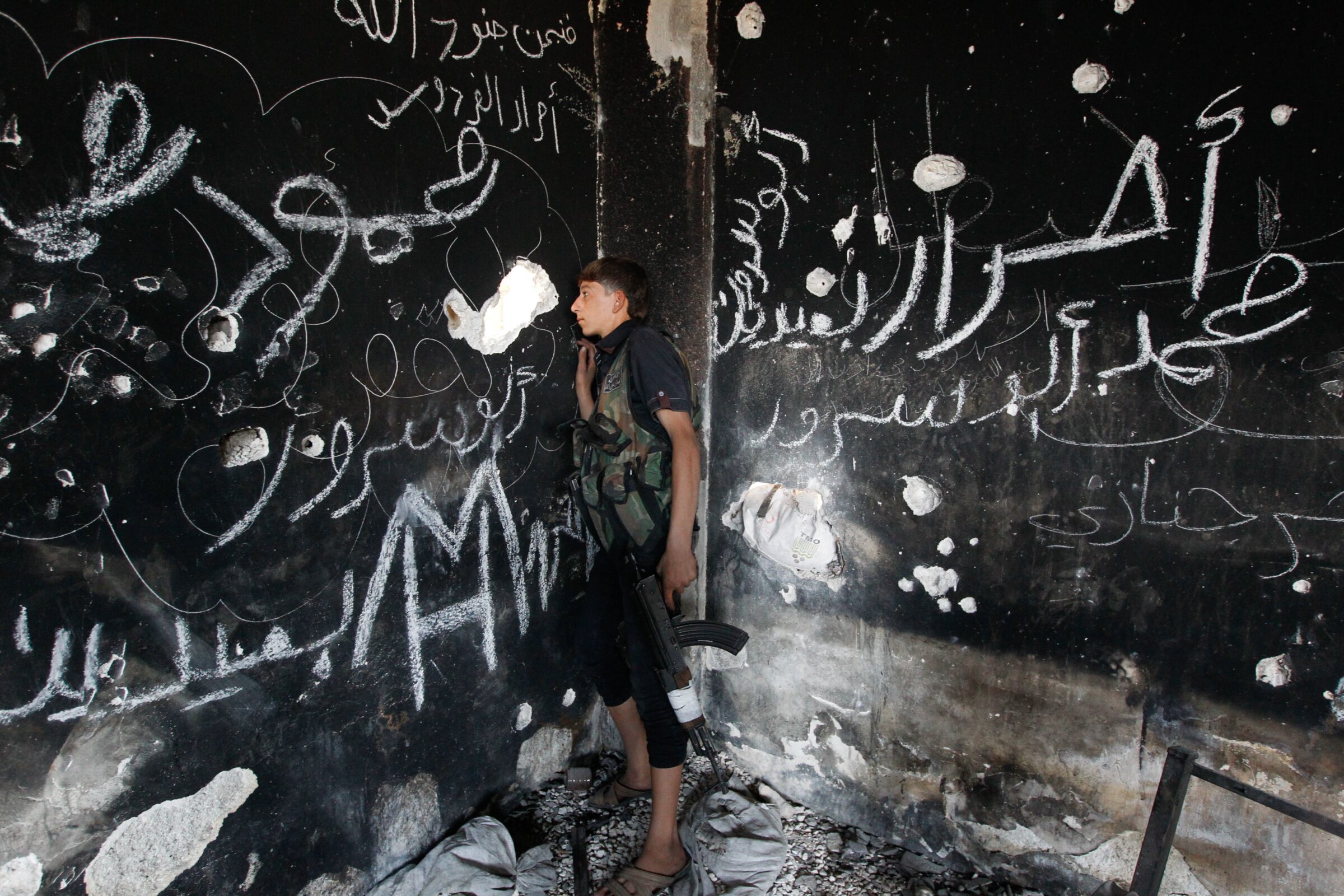On his 18th birthday, Muzaffar Salman received his first camera. Growing up in the ancient city of Homs, Syria, Salman was inspired by his father’s photographs of Europe and took up photography as a hobby. This interest stayed with him through college and a two-year military service. Eventually, Salman refined his craft and began his career working for Al-Watan, a daily Arabic newspaper aligned with the Assad regime.
Despite years of photographing political subjects, Salman says his first real assignment began on March 25, 2011– the day the Arab Spring protests erupted in his new home of Damascus. It marked the beginning of the Syrian Revolution, a large-scale movement against the authoritarian rule of the Assad government, whose family has held power in Syria since 1971. Widespread corruption and a destabilizing economy drove public disillusionment and growing calls for change.
Inspired by the wave of pro-democracy demonstrations sweeping the Middle East, hundreds of thousands took to the streets. “I heard the protests in al-Amawi mosque so I rushed there immediately with my camera. It was new for me to capture moments that will make history,” Salman told Reuters. From that moment on, he worked as a freelance photographer, documenting the uprising as it raged across the country.
Almost immediately, President Assad carried out deadly crackdowns in response to the uprisings. Over seven months of protest, nearly 3,000 people were killed. In an immediate public response, Assad blamed the uprisings on “conspirators,” condemned the protests as a “foreign plot,” and described those who were killed by the firing as a “sacrifice for national stability.” The brutality drew international outrage, prompting the United States, European Union, and Arab League to call for Assad’s resignation.

Journalists like Salman found themselves caught in the crossfire. Despite the danger, Salman’s photography of political activists, artists, and intellectuals proved not only powerful, but essential in shedding light on the stark realities unfolding in Syria.
In 2012, Salman published a photo capturing the triumph of a protest led by 28 activists, and was imprisoned. After his release, the Syrian military appeared at his mother’s doorstep, and demanded that Salman serve at a nearby base. As political protests spiraled into civil war, Salman made the decision to flee Damascus with his wife bringing only essentials––including his trusted camera. The couple made it to Beirut, Lebanon, just before Salman’s name was added to a list of individuals banned from crossing the border.
Life in Beirut came with its own challenges. Salman’s wife faced the looming threat of deportation because she lacked a passport. Meanwhile, as the conflict was intensifying across Syria, Salman found himself drawn back to document the unfolding events.
“My goal is not to provide statistics or data but to tell the human story—one deeply rooted in reality. I seek to reveal the truth of suffering and conflict, showing that they stem from the human soul itself rather than being mere unfortunate events, as they are often presented in the news,” writes Salman.
Fueled by his philosophy, he took repeated trips from Turkey into war-torn Aleppo–the epicenter of Syria’s brutal war, ravaged by relentless airstrikes, gunfire, and collapsing infrastructure. Leaving his wife behind, Salman ventured into the chaos to document war crimes, the resilience of civilians under siege, and the deepening humanitarian crisis.
In 2014, Salman’s series of risky crossings came to an end. Just as the couple learned that Lebanese security forces were tracking his wife, they were offered political refugee status in France, and fled for the safety of Paris.
Now, Salman lives in the city of Rouen, continuing his art through street photography. His Instagram is filled with reflections of Syria. One photo of sailors lined along the mast of a great ship is captioned, “Something mysterious I felt…when I saw those sailors enter the city in this way, all I know is that exactly the same feeling came to me ten years ago when I was photographing people fighting for their freedom.”
***
On December 8th 2024, thirteen years after Salman’s imprisonment, President Assad boarded a plane to Moscow as opposition forces poured into the capital city. In a swift, two-week offensive, forces led by Hayat Tahrir al-Sham (HTS)—which held de facto control over much of north-western Syria—seized several major cities across the country. Damascus fell last and with it the rule of the 50 year hereditary regime.
“For those of us abroad, everyone who could travel to Syria did so on the very first day,” Salman told the Politic, evidenced by the thousands of cars that jammed the main roads leading into the capital for days. “The truth is that I view the fall of the dictator Bashar al-Assad’s regime positively,” as do many, with over a million Syrians having returned home since.
Sam Heller, a fellow at Century International, leads policy research focused on the Middle East. He echoed the sentiments of Syrian refugees living in informal tented settlements in Lebanon. “The impression broadly was that…people were enthused about the fall [of Assad], and it alleviated some of the concerns that had previously kept them from returning…some of them had gone back to visit since December, some of them knew people who were still inside or who had gone back.”
The sudden end of the regime sparked hope and relief, but the reality on the ground remains unchanged. “Not everyone can return,” Salman said “as most people’s homes have been destroyed—including mine.” For many refugees Heller spoke to, “the country is still ruined [and]… for a lot of people, returning to a country in this condition seems unimaginable… there are no basic public services that they would need, including accessible healthcare or education for their children.”
***
Beyond the physical devastation, Heller argued that the economic challenges facing the country pose a significant obstacle for the new government. Many of the foundational structures needed for recovery are either non-existent or severely weakened, on top of hyperinflation, debt, and heavy sanctions. Before the civil war, Syria’s inflation rate was at 4%. The overall inflation rate in the months after the fall of Assad’s regime was just under 50%.
“[The new regime] does not have the resources so far… they took over a country in a state that is bankrupt, [and] ruined economically. [There is] no seeming indication that anyone’s going to step in and actually pay for all these military personnel. To run a government, obviously, there’s some very basic things that you need, like money and infrastructure.”

Despite these issues, Salman remained hopeful for Syria’s economy. As he pointed out, Syria has the potential to be a rich country, given its strategically significant location and resources, specifically oil and natural gas resources.
The labor force holds untapped potential, as Salaman described, “Syrians, by nature, are hardworking, and most of them are well-educated. Millions of them now hold international expertise and prestigious Western degrees, making them fully capable of transforming Syria into a developed and thriving nation.”
However, Heller noted that, “there is very little capacity in a lot of local markets to absorb new workers and to provide employment.” The question remains how the diaspora of Syrian talent and expertise can be drawn back.
A critical step toward economic revival, according to Salman, centers on international sanctions relief. “The biggest challenge right now is lifting U.S. sanctions on Syria, particularly those imposed by the Caesar Act.” The act, passed by Congress in 2019, put additional sanctions and restrictions on financial institutions and individuals in Syria. Lifting these barriers, said Salman, “is essential for Syria to rejoin the SWIFT banking system, allowing for reconstruction, infrastructure development, and foreign investment.”
***
Internal and External Dynamics
Another critical challenge for the new government is establishing unified control over Syria’s fragmented territory. According to Salman, “the new regime is linked to jihadist Islam, which does not reflect Syrian society.” Multiple armed groups currently maintain de facto control over different regions, including Turkish-backed forces (SNA), Kurdish forces in the northeast, and the Syrian Democratic Forces (SDF) led by Mazloum Abdi.
On the possibility of these factions uniting to form a stable government, Heller is pessimistic. “I’ve followed the Syrian war professionally since 2013 and over that whole period, there’s always some initiatives being cooked up for some sort of merger or consolidation of the opposition’s various factions and then it almost always fails.”
He pointed to HTS, SDF, and Islamic State of Iraq and Syria (ISIS), as the only groups that have established a monopoly of force in areas of their control. Everywhere else, “armed factions have a very specific local character, centered around a town, or a key personality, and have single funding streams. The act of actually pulling these factions together has never been recorded.”

Adding to the complexity, Syrians are not the only ones shaping their country’s political future, as regional and global powers continue to vie for influence and advance their own agendas. The issue of external influence is uniquely contingent on the security interests of Syria’s neighbors. As Jonathan Wyrtzen, a professor of sociology and history at Yale explained, “In relation to other countries that had uprisings in 2011 and went into various violent conflicts and different sorts of reform, revolt, revolution, Syria had a higher degree of external intervention because it’s in the middle of everything.”
To the north, Turkey looks to quell the threat of Kurdish forces, hoping to establish a buffer zone in Syria. This interest further complicates how the new regime will go about bringing factions together. “It’s questionable what Turkey’s line is,” said Wyrtzen “and how much flexibility President Al-Sharaa would have in integrating the Kurds and the SDF, because of Turkey’s interest there.”
To the south, Israel is advancing interests as well. The Israeli Prime Minister Netanyahu has called for a “complete demilitarization” of several provinces in southern Syria. Israeli military forces have indefinitely occupied southern Syrian territory and have launched missile attacks deeper into Syria, destroying military assets.
International policy towards Syria, such as lifting sanctions, will instead “depend on the behavior of the new leadership—not only in terms of transparency, openness, and the rule of law but also in their political acumen in forging alliances that create a balance in one of the most complex geopolitical battlegrounds, where global powers are competing for influence,” says Salman.
Despite these pressures, “I do not believe there is any real [territorial] threat of division,” said Salman. He claimed that “both regional and global interests are aligned in preventing chaos that could jeopardize these powers’ strategic interest.”
In Turkey’s case, for example, divisions could result in the creation of an independent Kurdish state, which would have serious regional repercussions, and could incite an independence movement in Kurdish regions elsewhere. “The main regional powers have no interest in seeing Syria split…[as] this would mean a complete redrawing of the Middle East map and, with it, the balance of international power,” Salman stated.
Wyrtzen made the case, however, that the removal of sanctions and economic relief from the international community is predicated on something deeper. “Usually, [aid and sanctions] are used to make a Syrian subservient,” he explained, “or to subjugate basically a weaker state…in the service of [almost] Western imperial power.”
External intervention has long complicated Syria’s path to power consolidation. Wyrtzen pointed to Syria’s last major constitutional moment in the aftermath of World War I, when Arab and British forces liberated Damascus. After Faisal I was declared king, he established a provisional government to create an independent Arab state. The Arab Congress in Damascus drew delegates from across the region, including modern-day southern Turkey, Jordan, and Israel-Palestine. During the Congress, members “[came] up with…some kind of a constitution, but that summer, the French sent an army over that just violently quashed it and ousted Faisal,” Wyrtzen explained.
***
A New Constitution
President al-Shaarah has signed a five-year constitutional declaration, rooted in Islamic law promising “freedom of opinion, expression, information, publication and press.” It has been praised in part for its protection of individual rights, women, and minorities. However, critics are skeptical. “There are also clauses that seem like they could pretty easily be used to subvert and weaken those rights, and it concentrates a really substantial amount of power in the Executive and the President” said Heller. “Other separate and coequal branches of government are largely, per the terms of this announcement, going to be nominated by the President himself. Such provisions certainly make this transitional arrangement ripe for autocratic consolidation.”
But Wyrtzen added a nuanced perspective on the constitutional moment: “One of the things that I think is important in a situation like this is to distinguish what a constitution is doing. Is it a document? Is it a guideline?” This question becomes particularly relevant as the Kurdish-led SDF and other groups have already declared their “complete rejection of the constitutional declaration submitted by the interim government.”
Wyrtzen, however, emphasized that: “In and of itself, [the constitution] isn’t reality, and it can’t create reality.” What Syria truly needs, according to Wyrtzen, “is a kind of Philadelphia constitutional convention moment where you can bring people together and hash out a power-sharing bargain.” However, given the intense external pressures facing the country, he acknowledges that “they don’t have the luxury of doing that.”

***
“In general, my friends and siblings in Syria are cautiously optimistic,” said Salman. “On one hand, they feel a sense of relief. On the other hand, the future remains uncertain.” For now, Salman continues to capture life in Rouen––the trees in nearby parks, water rushing in small streams under bridges––through the grayscale lens of a refugee far from home.
His own return is complicated, citing massacres of Alwaites and religious extremists as one of many reasons holding him back. In his view, amidst continued instability, to return to Syria and give up his legal status in France would be “reckless.”In the wake of loss and devastation in Syria, beats the heart of hope. Hope cannot answer all the hard questions, but it can light the way forward. Salman’s life and work defines what it means to carry that spirit. “If I were in Syria now,” he says “I would certainly be documenting what is happening, even though it would not be easy. But then again, it never has been.”

